
|
|
A visit to AP Racing February 2007 As you might have read in the Modifications section in the My car menu, my car has the first ever AP Racing Formula big brake kit for the Celica ST185. Since this was the first ever kit for the ST185, I drove the car to AP Racing in Coventry, UK, to have the set installed and tested. In this article you can see what is done during the installation of my AP Racing brakes. I also try to show what work and steps are involved when a new brake system is being developed by AP Racing since I was given an exclusive view behind the scenes throughout the entire Coventry headquarters. The pictures used in this article which I marked with a copyright for AP Racing Ltd. were taken by AP Racing. Due to a dyno test session of an unknown (couldn't see which team they were from unfortunately) Formula 1 team I was forbidden to take pictures inside myself. 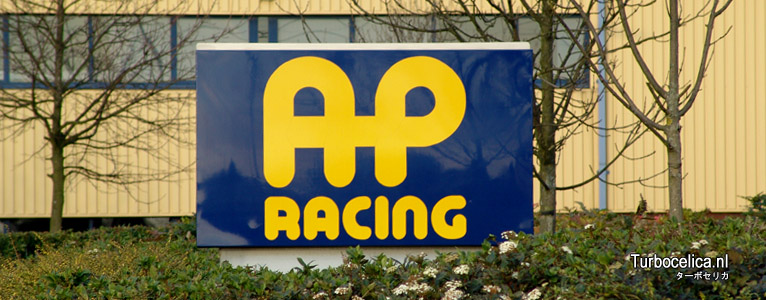 Fitting the ST185 Formula big brake kit When arrived at the AP Racing site I met Pete Collen, the man I've been in contact with since the first inquiry e-mail. He works quite a while at AP Racing and turned out to be a great guy. He told me to drive the car around so we could start the fitment right away. After driving the car up the ramp and removing the wheel and old brake setup, the first step was to clean the entire hub by brushing rust away. This way any possible imbalance caused by a rusted hub surface was eliminated: 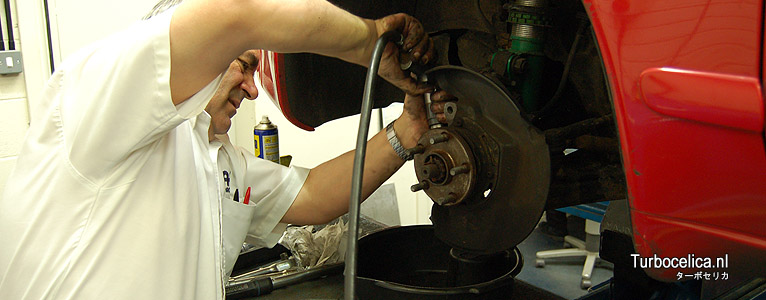 Next up the splash guard was slightly bent away to create room for the huge 330x32 mm two piece disc which was dry-fitted on the hub: 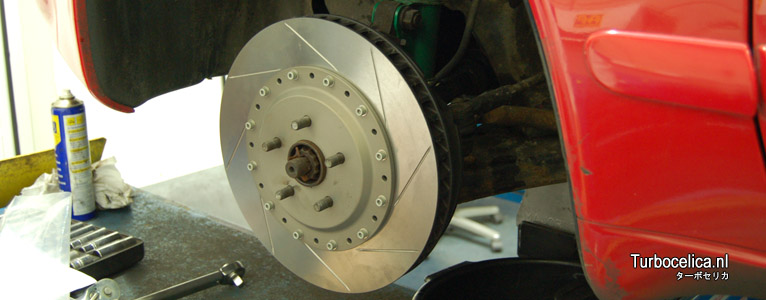 Copper grease is added to the hub flange to reduce the chance of corrosion between the interface of the steel hub & aluminium mounting bell. Steel, aluminium and road salt coupled to a vehicles electrical current can cause electrolysis to take place between the alloy and the steel i.e. corrosion, copper slip grease reduces the effects. This thin film is in no way detrimental to the stability of the disc. The splash guard was also cut so the caliper bracket would fit nicely:  The disc went back on to check for possible imbalance. To test this the disc went on in all five possible ways to compare the readings. Out of the 5 results the best configuration was chosen to mount the disc on the hub:  Next up was the CP5570 caliper which was bolted onto the bracket. A nice detail is that AP Racing uses specially heat resistant coated bolts only in their Formula big brake kits.  Below you see a view on the pistons inside the caliper. Because the setup is leading - the caliper is mounted in front of the axle looking at the driving direction - the lowest piston is the biggest. This way it neutralizes the extra friction the disc causes by pushing the brake pad downwards in the caliper. The result is an equally spread pad pressure. 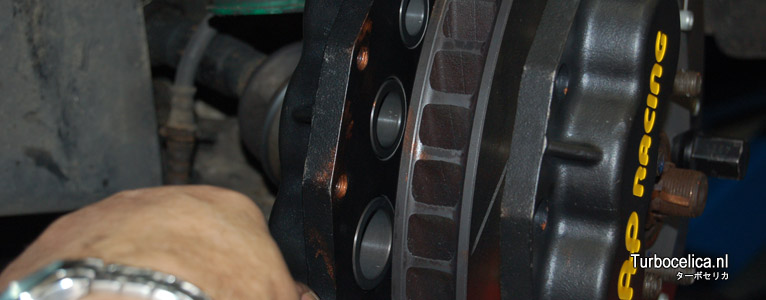 After the brake pads were fitted together with the anti-rattle plates, the Goodridge braided brake lines were installed. Goodridge made the brake lines using a stock ST185 line I sent to AP Racing to check the length and banjos needed to accept both the Toyota and AP Racing bolts. Once again the hardest part of the fitment was disconnecting the old corroded line from the chassis, like I experienced with the rear brakes. After the same steps were taken on the other side, it was time to bleed the brakes and insert the AP Racing dot 5.1 brake fluid. During the bleeding a lot of fluid was pumped through the lines to flush the system. After topping the reservoir up for the last time the install was completed. Next up was a test-drive. While increasing the brake pressure, the next step in this test was taken by judging the colour of the disc. When this bedding in process was started properly it was time to head back for the AP Racing factory again. Developing a completely new brake setup After an inquiry for a new brake kit is received by AP Racing, the first step is to calculate what size disc and caliper will be needed to provide the stopping power requested. If a completely new disc or caliper needs to be developed, the process starts in the design department:  In case of new parts, plastic mock-ups are made to check actual fitment on the vehicle. Next up the prototype parts get fabricated and tested. To test calipers they are connected to a brake line to simulate braking. The test cycle of such a test is 500,000 with a specified line pressure applied plus end load applied to simulate brake torque. This test is carried out on three separate calipers, after which they are burst tested to destruction. 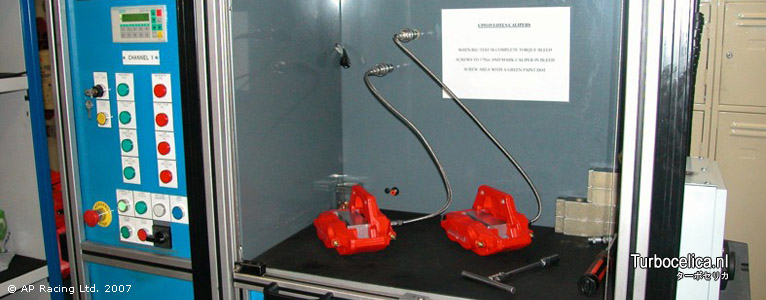 Calipers and discs are also tested on a dyno where the caliper stops a spinning disc instead of clamping an aluminium block like in the pressure test. This way the actual braking force under different (brake) temperatures can be measured. Pictured below is the spectacular test of a carbon/carbon brake setup using a single piece racing caliper: 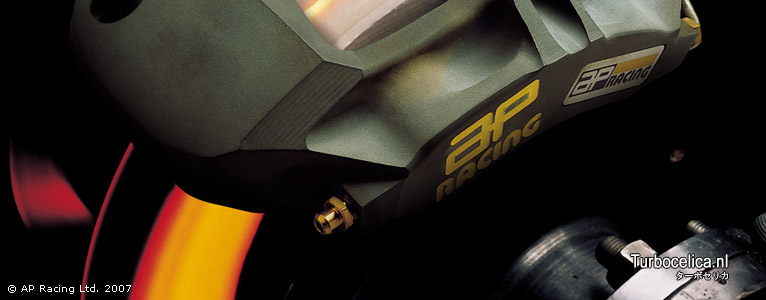 If all tests turn out ok, the parts are taken into production. The production process of all brake parts takes place within the AP Racing complex. After the 'AP Racing' or car manufacturer's logo and other information is machined into the caliper parts they get coated and painted in the final colours.  Above you see the Coventry main workshop. Here the calipers are being built, inspected and stored. Brake discs and bells are bolted together and all parts are packed for shipment in another part of the workshop. While walking along the heart of the plant I was amazed by the number of parts everywhere.. 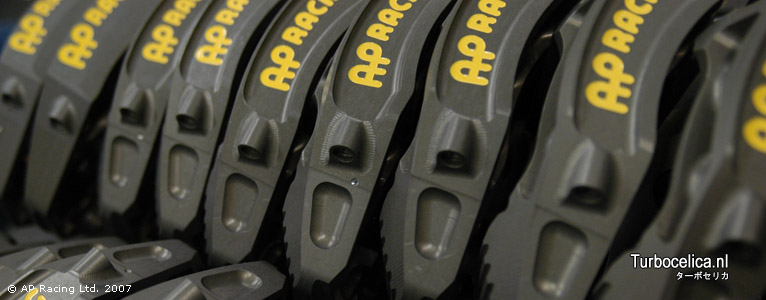 Overhauling various special parts like huge Bugatti Veyron calipers and tiny (97 mm diameter) Formula 1 carbon clutches also takes place here and that shows the many motorsport parts AP Racing offers. It's not brakes alone that are impressive to see. WRC pedal boxes and clutches, it's all functional art really. What I wasn't aware of is that besides upgraded units, AP Racing also produces quite a lot of OEM clutches for various road going cars; interesting! After seeing and feeling the various motorsport parts our guided tour ended. It was very interesting to see the passion involved in being one of the leading and most successful manufacturers in motorsport brake and clutch parts*. AP Racing stickers everywhere, lots of interest for the installation of my setup, it's just cool to see really. From brake cylinders to GT car air jacks, AP Racing offers very sophisticated parts and I'm proud to have their first off Celica ST185 Formula big brake kit on my own Carlos Sainz! * Some of the 2006 championship winners using AP Racing parts: Formula 1 (Renault R27 - brakes/clutch), A1 GP (France - brakes/clutch), both British and European Formula 3 (brakes), various Nascar classes (brakes), 24h Le Mans (Corvette C6.R - brakes/clutch), JGTC GT500 (TOM'S Toyota SC430 - brakes/clutch), JGTC GT300 (Re-Amemiya Racing Mazda RX-7 - brakes), BTCC (Team Halfords Honda Civic - brakes/clutch), DTM (AMG Mercedes - brakes/clutch), WRC (Citroen Xsara WRC - clutch). Special thanks go to Pete Collen of AP Racing for keeping me up-to-date during the development of my setup, installing the set on my car, giving us a great tour and exclusive view behind the scenes and providing additional info and pictures for this very article. Thanks again for a great experience, good chat and best customer care I've come across so far! Publishing of the above article at Turbocelica.nl has been approved by AP Racing Ltd. UK.   Related links Related linksAP Racing AP Racing Formula 330x32 mm 6 pot big brake kit Tech articles The search for proper stoppers Top |
|
|